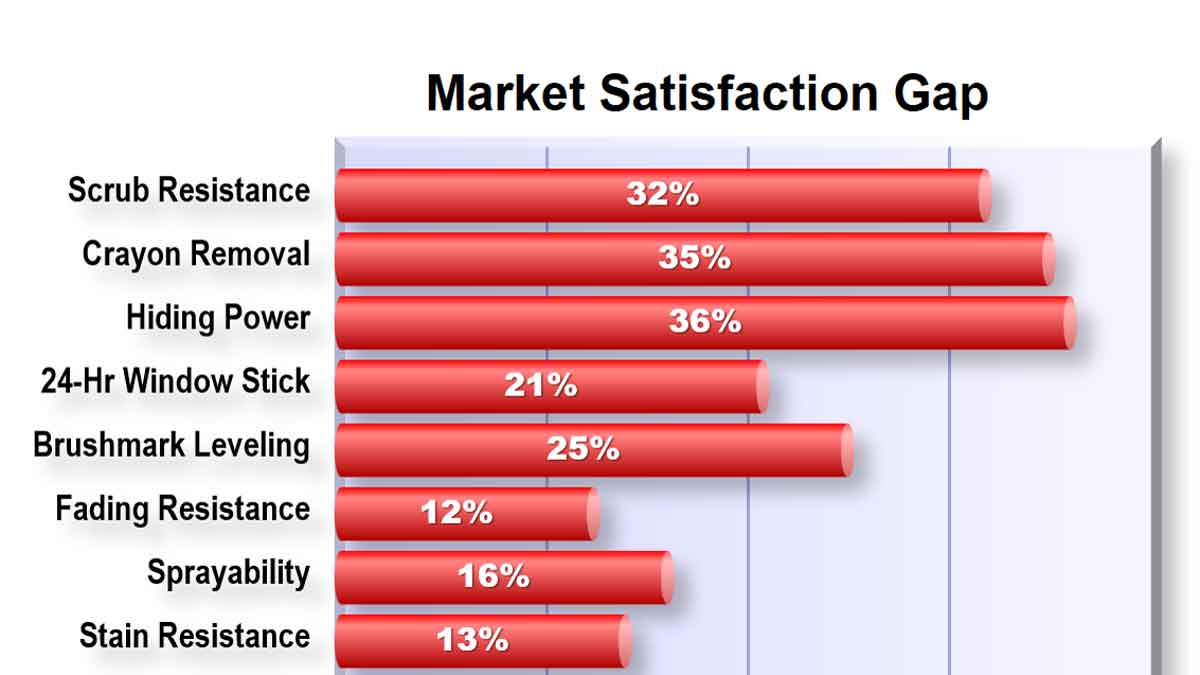You’re developing your customer’s new product. It’s like this: “Mr. Customer, we’ve assembled a team aimed at developing something you’ll love. As you can see, we even brought a lead R&D person with us to listen to you. So can you tell us everything you think we should know before we going into our labs? We want to get this right so the innovation makes you a hero at work.”
More in article, Reduce Bias in Voice of the Customer
This can super-charge your organic growth: Don’t let your R&D conduct any product development work without unbiased, unfiltered data on what customers do and do not want. Market Satisfaction Gaps—based on importance and satisfaction scores for customer outcomes—provide this. You’ll free up enormous resources by working on only what matters.
More in white paper, Catch the Innovation Wave (page 13).
What else is there besides hearing customers’ needs? Impress them so they’ll want to do business with you. Incorporate your insights into a value calculator to optimize pricing. Use their precise interview language on your website to improve SEO. Uncover unspoken needs in a post-interview customer tour. Understand their next best alternative. Never stop learning.
More in article, You Already Answered 4 Questions, but… Correctly?
It’s usually a sign the new-product team has a supplier-centric mindset, not a customer-centric one. Validating hypotheses is converging around a supplier solution… which should occur after diverging around customer needs. It’s important to get the sequence right. Look around and study Problem Solving 101: Divergent thinking nearly always precedes convergent thinking.
More in article, Reduce Bias in Voice of the Customer
I worked in manufacturing in the 1970s, when it seemed like “overkill” to train operators in statistics for quality control. But this is expected today. I met Dr. Deming in the 1980’s and heard him say, “It is not necessary to change. Survival is optional.” Compared to statistics, the science of B2B customer insight is quite simple. Will you be GM or Toyota in the innovation wave?
More in white paper, Catch the Innovation Wave (page 12).
I call this the golden rule of investment. In the case of innovation, it explains why the front-end-of-innovation is the critical battleground. The winning company is the one that most efficiently learns whatever intelligence is needed to drive this important decision: “Should we advance this project into the costly development stage?”
More in article, Should Your Stage-Gate® Get a No-Go?
We asked how much B2B-optimized interviews impacted teams’ designs for the products they were developing. Five out of six teams said the impact was “great” or “significant.” Hmmm… makes you wonder what those products would have looked like without these interviews. Do you think your new products could be improved this way?
More in white paper, Guessing at Customer Needs (page 2).
Many companies develop and lob new products at their B2B customers without first exploring their needs. There may be less efficient ways to understand customer needs than waiting to see if they buy your product… but I truly don’t know what they would be. Years from now, companies will be amazed that our innovation methods were so supplier-centric and inefficient.
More in white paper, Timing is Everything (page 5).
This is what product developers call the Ansoff Matrix quadrant where you pursue an unfamiliar market with unfamiliar technology. A great place to kill your career. But you can enter it with confidence when you apply new methods for de-risking transformational projects… moving from uncertainty to certainty to defuse potential “landmines.”
More in article, De-Risking Innovation: How to Thrive in the Suicide Quadrant
Which business leaders do you admire… Henry Ford… Jeff Bezos… Elon Musk… Steve Jobs? Why do you admire them? Because they were great at slashing budgets, running financial review meetings, or giving quarterly EPS guidance? Here’s the irony: Many business leaders behave quite differently than those they admire.
More from in article, How to become a great business leader
The #1 culprit for wrong facts is the untested assumption. Someone thinks the customer would like this or that, and the assumption morphs into a “fact” over time. A missing fact occurs when an important question is not answered. The overwhelming reason is… it’s never asked. With proper B2B customer interviews, you can avoid most wrong and missing facts.
More in article, Should Your Stage-Gate® Get a No-Go?
I love it when our clients have cool technology and clever ideas. But don’t mention these to customers during VOC interviews. From the customer’s perspective, the interview should look exactly the same whether or not you’ve got a great hypothesis. Give your hypothesis the silent treatment for now. Simply listen to the customer.
More in article, Give your Hypothesis the “Silent Treatment” (Originally published in B2B Organic Growth).
Strong intermediate (vs. ultimate) innovation metrics share these qualities: 1. Insightful: They help firms understand relationships between cause and effect. 2. Predictive: They measure behavior that will foretell ultimate success. 3. Actionable: Their short “feedback loop” allows rapid adjustments to be made. Are you using such metrics?
Read more in the article, 3 Problems with Innovation Metrics
(Originally published in B2B Organic Growth newsletter).
Consider four steps: 1. Understand value, learning which important outcomes customer lack. 2. Quantify value, estimating the potential value beyond customers’ next best alternative. 3. Build value, by developing a new offering. 4. Communicate value, with a dynamic launch. Most companies can get much better at steps 1, 2, and 4.
More in article, Three Steps to Unbeatable Value Propositions (Originally published in B2B Organic Growth newsletter).













